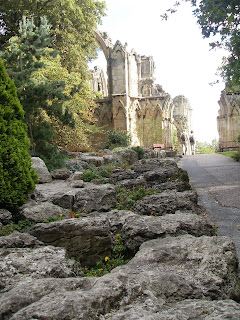Sing unto him a new song; play skilfully with a loud noise.
- Psalm 33:3
In the course of my thesis work I spend much of my time in the Middle Ages, reading Medieval texts, reading about Medieval texts and of course writing about Medieval texts. Many of these texts are liturgical texts, antiphons, responsories, versicles and so on, and I have to admit I'm less than fluent in this particular field of scholarship. In an attempt to acquire a better understanding of the material I'm working on, and in order to get in a proper "Medieval" mood, I usually listen to Medieval music when I'm writing. In this blogpost I would like to share a few of my favourite songs. This selection encompasses works meant for an ecclesiastical setting as well as the temporal sphere, including both liturgical pieces and dance music.
I feel obliged, however, to comment briefly on the title and the matter of dividing Medieval music into categories. The dichotomy sacred/profane was first formulated by the French sociologist Émile Durkheim (1858-1917) and it is accordingly an anachronism in this contexts since this was not a division employed by Medieval musicians. On the whole it is difficult to use Durkheim's dichotomy when describing the Medieval world, for the borders between sacred and profane were sometimes very blurry and sometimes virtually indistinguishable. Bishop Anthony Bek of Durham (d.1311), for instance, was both bishop and King Edward's official during the king's Scottish campaign.
There did exist a division, however, between the spiritual world and the temporal world, between the matters pertaining to salvation and the immortality of the afterlife on the one hand and the matters pertaining to the affairs of mortal and sinful men on the other. The Church naturally was in charge of the spiritual sphere, wielding the sword of God to paraphrase Augustine, while the monarchy was responsible for upholding the waning world, wielding the temporal sword and doing so under the auspices of the Church. At least this was the ideal, harkening back to Augustine and Pope Gelasius I (d.496), and this was also the cause of much contention between the king and the clergy throughout the High Middle Ages.
In Medieval music, however, this is a much more difficult division to make. We can, of course, safely say that liturgical pieces belong squarely in the spiritual sphere since they were intended to celebrate the life and times of Christ and the lives and deaths of the saints. Other pieces were undoubtedly temporal, such as dance music for bagpipes. Some songs are, however, quite difficult to place and most likely we should not even try too rigorously to categorise them. An example of this is the Roman de Fauvel, a work written by Gervais du Bus c.1316 and interspersed with musical pieces old and new. Although the work is written in French and intended for a temporal setting - it is a didactic text for the newly-crowned king Philip V of France - it treats matters of the spiritual sphere, admonishing the king to avoid the vices of the world and improve what is at fault in France lest the Antichrist strikes and ends the world as they knew it. The subject is therefore both temporal and spiritual at the same time and shows very nicely how averse reality is to simplistic categorisation.
From Messe de Notre Dame by Guillaume Machaut (1300-77)
Nuper rosarum flores by Guillaume Dufay (d.1474)
Supremum est mortalibus bonum by Guillaume Dufay
Psalm 2 as used in Le Roman de Fauvel
Ai vist lo lop, anonymous Occitan song, probably 13th century
14th-century saltarello, anonymous










































































